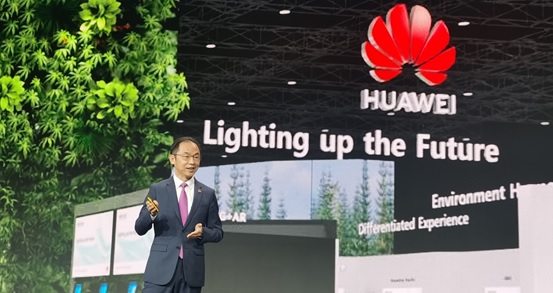
Huawei’s Ryan Ding: Ongoing Innovation Is Lighting up the Future of Every Industry
During MWC Barcelona 2021, Huawei Executive Director and President of Carrier BG Ryan Ding delivered a keynote speech Innovation: Lighting up the Future. In his keynote, Ding said that innovation in ICT is becoming a key driver of the global economy and its value is moving beyond the telecoms industry. Ongoing innovation in 5G, in particular, will bring more value to operators, the ICT industry, and the global economy, and will light up the future of every industry.
Ryan Ding delivering a keynote
More than telecoms: Innovation in the ICT industry is becoming a key economic driver
The pandemic, Ding said, has created a new normal in which the digital economy is the driving force for the global economy. ICT infrastructure, as the cornerstone of the digital economy, is playing an increasingly important role. Ding mentioned that the value of ICT now transcends the telecoms industry and has transformative implications for the global economy as a whole.
In countries where 5G is developing faster, operators have seen faster revenue growth, and these countries also tend to have better digital infrastructure overall. Taking China as an example, in less than 18 months, more than 820,000 5G base stations have been deployed, and Chinese operators achieved a 6.5% increase in revenue and a 5.6% increase in net profits in the first quarter this year. The rapid development of digital infrastructure driven by 5G will add EUR1.9 trillion to the Chinese economy in the next five years. The same stories are also unfolding in South Korea and Europe.
More than connectivity: 5G innovation is enabling operators’ business success
As ICT infrastructure is the cornerstone of the digital economy in the 5G era, operators are playing a more important role than they used to.
Ding said, “Currently, the major goal of operators in 5G is to achieve business success in three key markets – consumers, homes, and industries – through innovation in network deployment, market development, and operation optimization.”
“In the consumer market, 5G means not just faster speeds; it also brings new experiences and new value. Some operators have already achieved initial business success.”
According to Ding, there are three steps an operator can take to succeed in the 5GtoC market. The first is to speed up 5G deployment, with targeted network planning and investment based on precise insights into high-value areas, key scenarios, and potential users. The second is to accelerate 5G user migration, and the third step is to create value-driven, flexible pricing models.
Today, 5G has been applied in over 1,000 projects in more than 20 industries including steel and mining, enabling safer and more efficient production. Chinese operators have made great progress and are entering the phase of taking early successes and replicating them at scale.
“We’ve learned from Chinese operators’ experience that the success of 5GtoB depends on three factors,” said Ding. “First, selecting the right industries. Operators should choose target industries by looking at four factors: demand, affordability, replicability, and technical feasibility. Second, defining the scope of your offerings. Operators can serve as network providers that offer connectivity services. They can also serve as cloud service providers, or even system integrators that provide end-to-end integration services. Different roles require different skillsets and yield different business value. Third, designing innovative business models. This is key to replicating 5GtoB success at scale.”
During the pandemic, there is a growing demand for home broadband, and this has highlighted the advantages of 5G FWA that enables rapid deployment and contactless O&M. Middle East operators have achieved remarkable commercial success by taking FWA as a key use case of 5G.
More than business: Huawei keeps innovating to drive industry-wide sustainability
“5G success first requires a 5G network that provides the best user experience, and this guides how we innovate at Huawei,” said Ding. Huawei has launched the industry’s lightest and most powerful Massive MIMO that consumes less energy. It can be carried and installed by just one person, which speeds up network deployment. With Huawei’s Optical Cross-Connect (OXC), one sub-rack can replace nine cabinets normally needed. It has four times larger capacity, but uses 95% less power. Huawei’s 5G Super Uplink solution combines the advantages of 2.1 GHz and 3.5 GHz to enhance uplink capacity and indoor coverage. This solution provides a peak uplink rate of over 450 Mbit/s, enabling hundreds of users to live stream the Xiamen Marathon in 4K in April using their 5G smartphones.
To support green development models and carbon neutrality, according to Ding, Huawei keeps innovating at three levels: equipment, sites, and networks. At the equipment level, Huawei uses components with higher power efficiency to make hardware platforms more energy efficient. At the site level, Huawei’s simplified site solutions help operators lower energy consumption, as well as save on electricity and rent. At the network level, Huawei has launched a multi-band and multi-RAT power saving solution. This solution can cut energy consumption in wireless networks without compromising network performance. With Huawei’s innovative solution, 5G equipment working in low and high bands can share a cabinet, and as a result, less energy is used. When it comes to multi-band equipment power saving, Huawei’s goal is to make one plus one less than one.
Collaborating to create an ecosystem and evolving 5G for a better future
Concluding his keynote, Ding emphasized that 5G development requires ongoing innovation. In 5GtoB, for example, 5G standards need to be coordinated with industry standards at a faster rate, and 5G should be integrated into enterprises’ core production processes to help them go digital and intelligent. At the same time, the synergy between 5G, cloud, and computing will further expand the boundaries of operators’ business, creating space for new growth. 5G innovation is an ongoing process. Huawei believes that innovation will light up the future.